Unpredictable hip pain is scary. It acts up without warning and makes us afraid to move and exercise. Fortunately, it’s quite common and usually isn’t a serious problem.
In this article you’ll learn what causes sudden, sharp hip pain that comes and goes, the best exercises for it and signs you may have a serious hip problem.
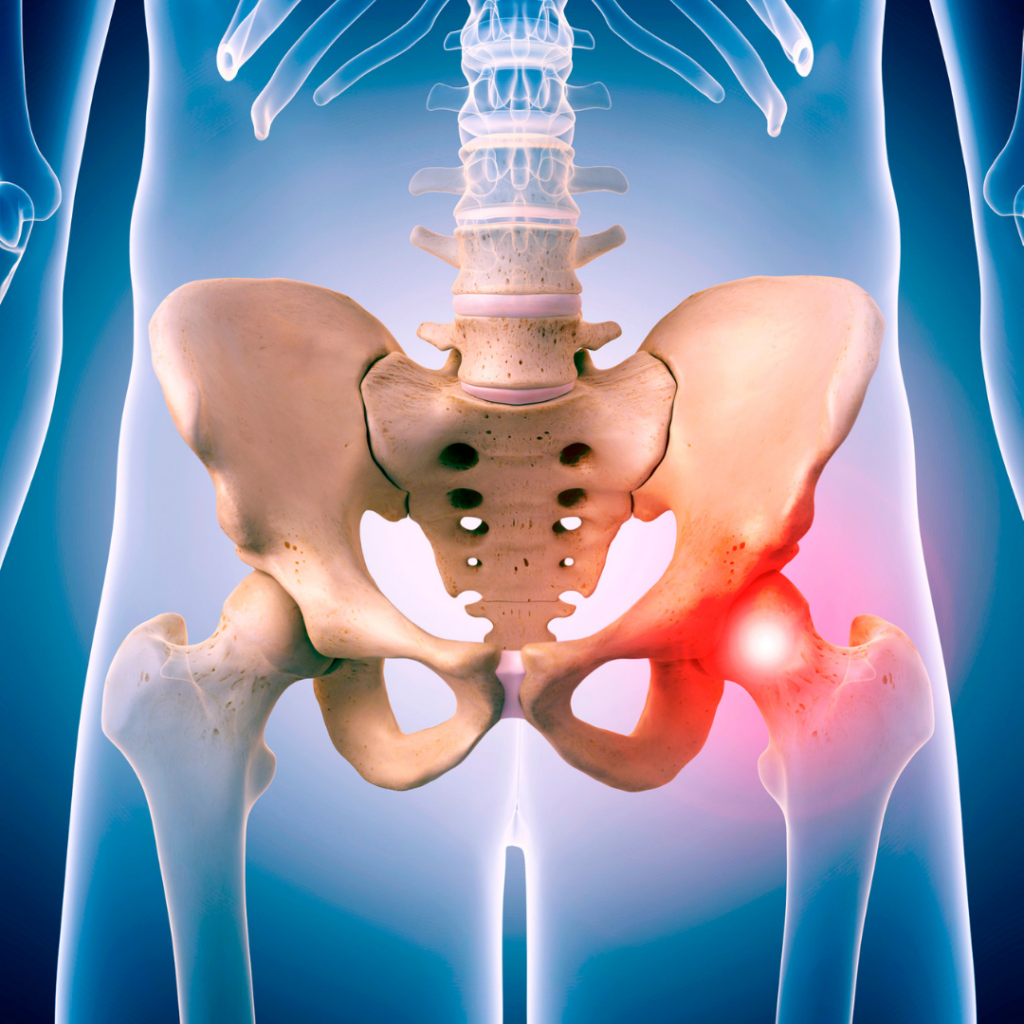
Anatomy
The hip is a strong, stable ball-and-socket joint. It’s ultra sturdy, which is great because it handles large forces from weight-bearing and high impact exercise.
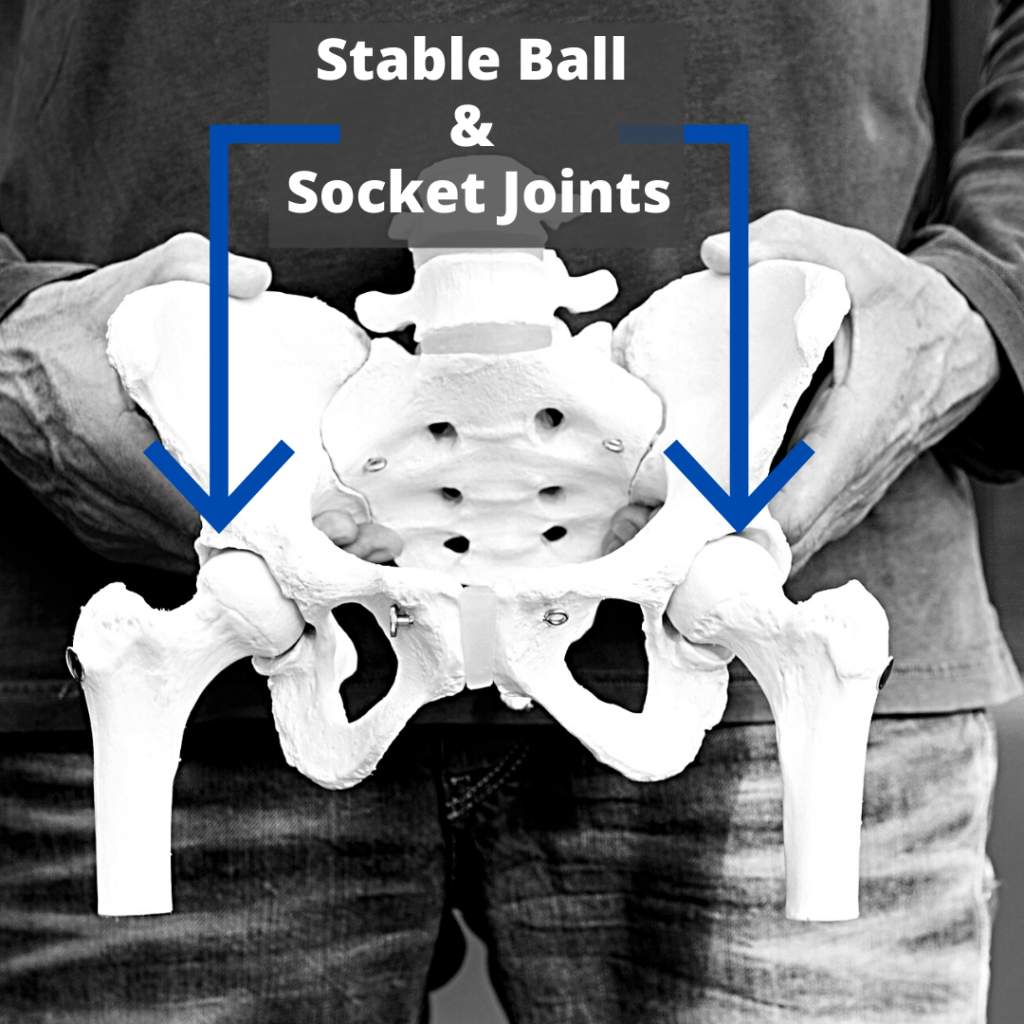
Dozens of muscles surround the hip. We’ll focus on two key muscles.
Gluteus Maximus
The gluteus maximus, our biggest hip muscle, forms the meaty part of our buttocks. It’s a powerful muscle that extends and externally rotates the hip. Think of how speed skaters and cross country skiers push their legs back and out to propel them forward – that’s the action of the gluteus maximus.

A strong gluteus maximus stabilizes the SI joint, enhances hip function and allows us to squat, lunge, and climb stairs with ease.
Gluteus Medius
The gluteus medius is another critical hip muscle.
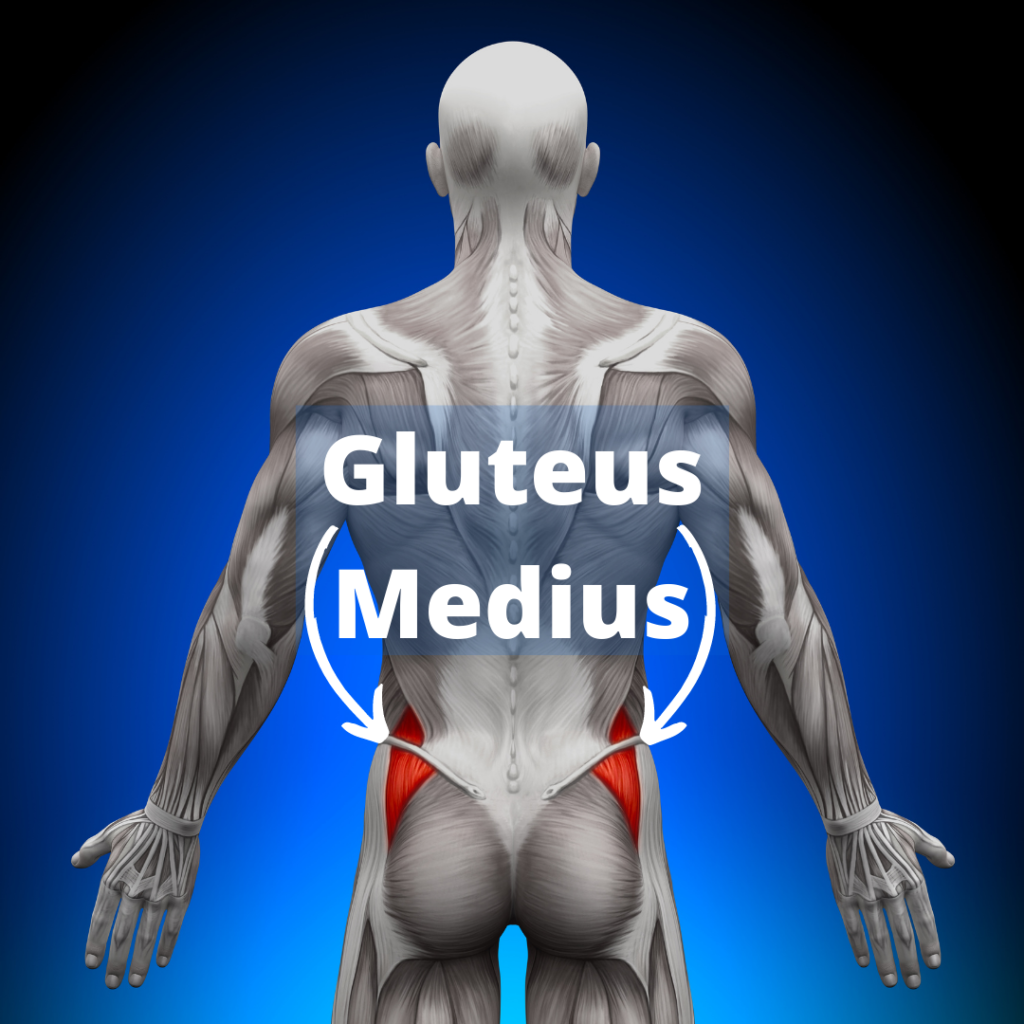
It sits on the outside of the hip and performs hip abduction.
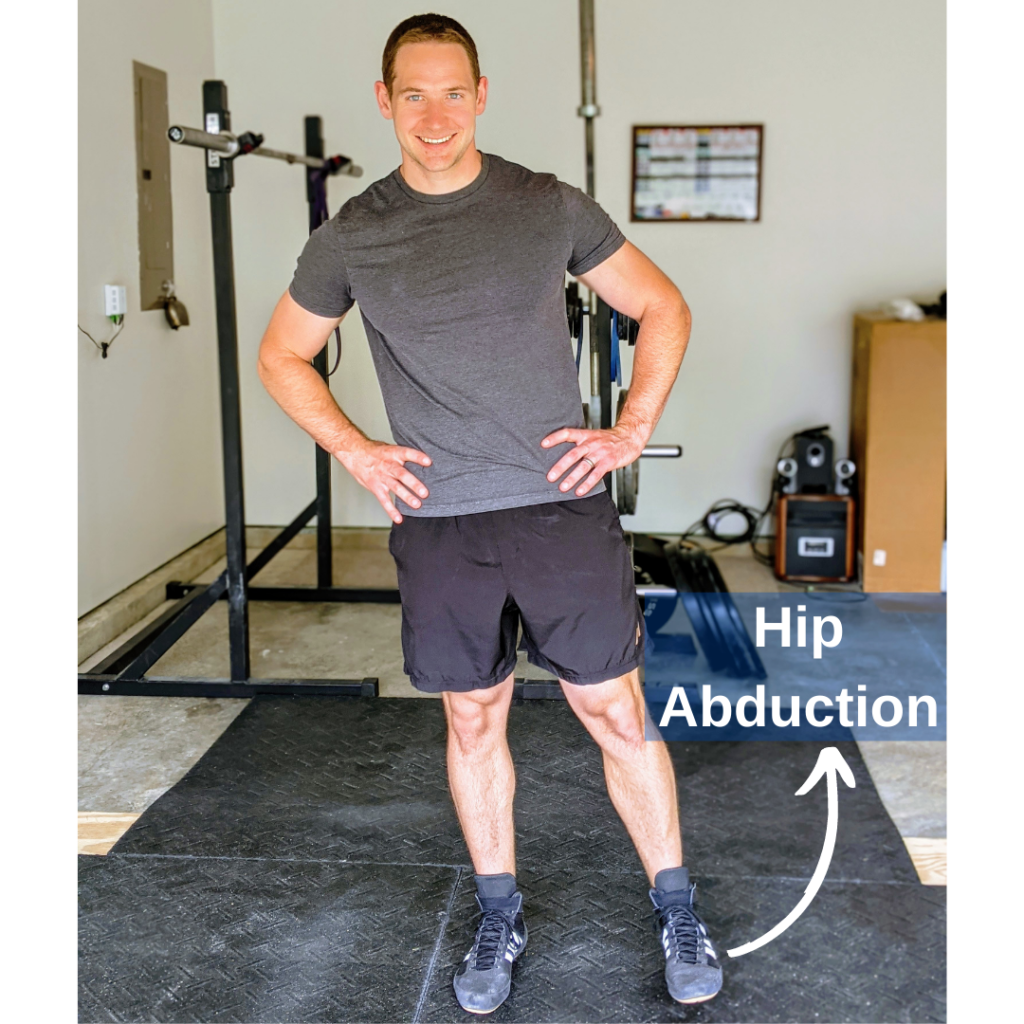
Functionally, it keeps the pelvis level when we stand on one leg.
The gluteus medius helps us squat, run and jump with optimal lower body mechanics. It’s a common source of pain on the outside of the hip. More on that later.
Common Causes of Hip Pain
These culprits cause unpredictable hip pain that comes and goes without warning.
Hip Osteoarthritis
Osteoarthritis (OA) is known as “wear-and-tear” arthritis (1). Hip OA affects the cartilage inside the hip joint. Arthritis sounds pretty scary, but it’s usually pain-free and it’s a normal part of the aging process. A lot like getting wrinkles on our faces as we get older.
Symptomatic Hip OA affects 9% of adults over age 45. Another 18% have hip OA on X-rays but don’t have pain! (1)
Hip arthritis often causes a dull ache around the joint. But sometimes it causes severe pain–pain that feels sharp, sudden and stabbing (2).
With hip arthritis, range of motion is limited and the hip joint feels stiff. Internal rotation mobility is especially restricted (3).
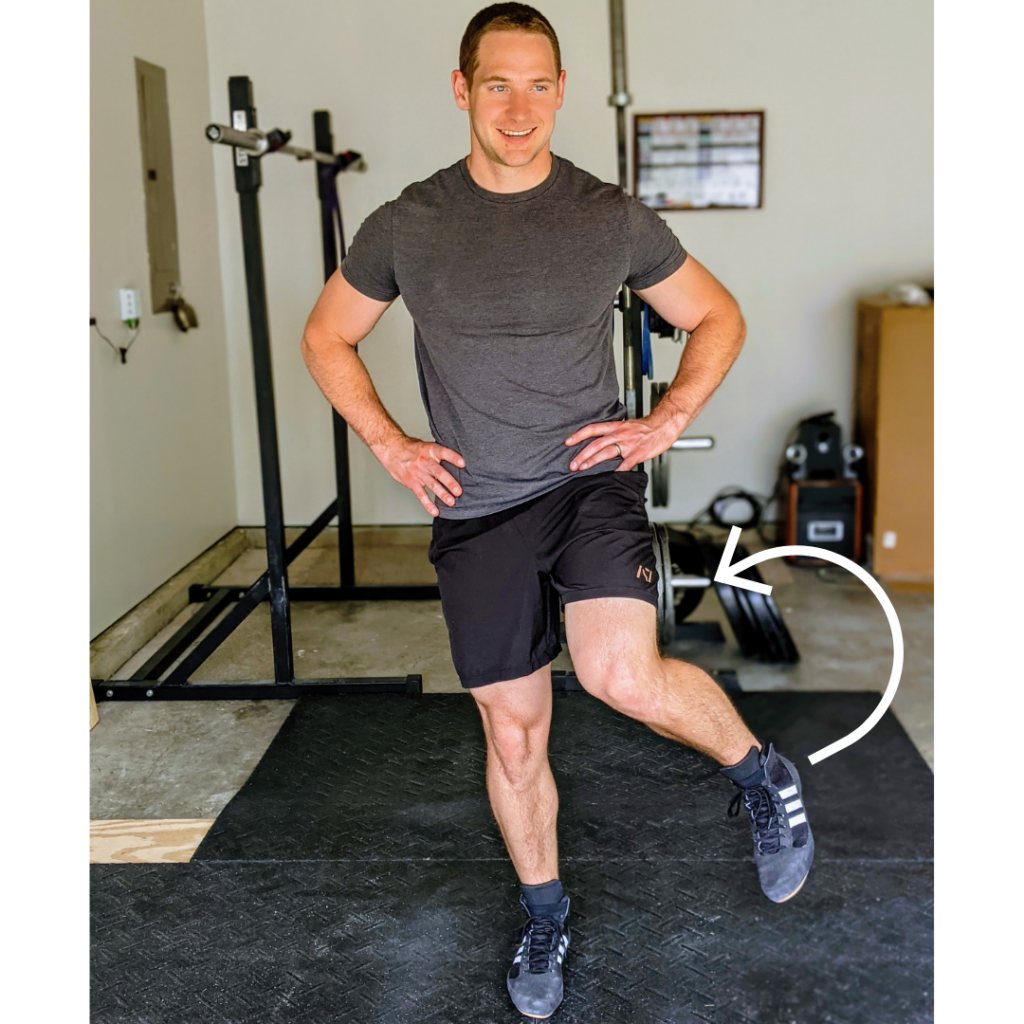
Squatting, kneeling and stairs are often painful. Groin pain is a hallmark symptom of hip arthritis; hip joint problems send pain to the groin area (1).
Mild and moderate hip OA respond well to physical therapy treatments like strengthening, mobility exercises and manual therapy (3).
Weight loss is another key to managing hip arthritis for those who are overweight (3).

Obesity causes systemic inflammation in the body. Healing takes longer and the body’s pain system becomes more sensitive.
Plus, the hip has to handle higher forces from the excess weight. Losing 10lbs can reduce loading on the hip joints by 60 lbs! (1)
Want to lose weight and eat better? Check out this easy-read, evidence-based guide to get started.

Severe hip arthritis warrants hip replacement surgery if the hip pain and stiffness is debilitating (1).
Femoroacetabular Impingement
FAI, also known as hip impingement, affects people from 25-50 years old (4). It’s caused by bony overgrowth around the hip joint–either at the femur (the ball) or the acetabulum (the socket), or both.
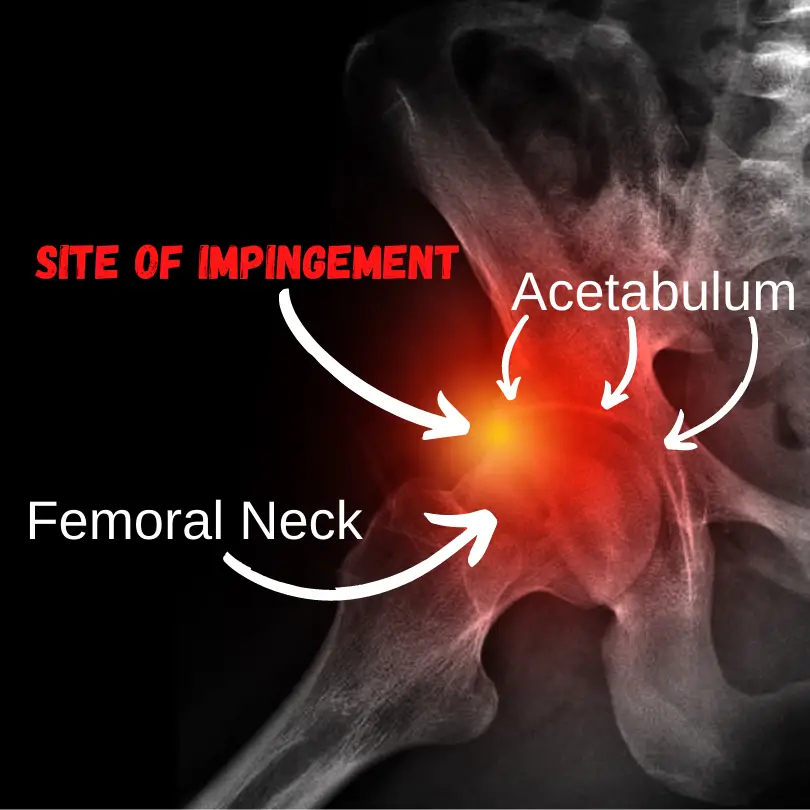
These structural changes cause a pinching type of pain at the front of the hip. Other symptoms include stiffness with squatting and bringing the knee towards the chest. Sitting in low chairs is uncomfortable. Activities that require hip flexion are painful.
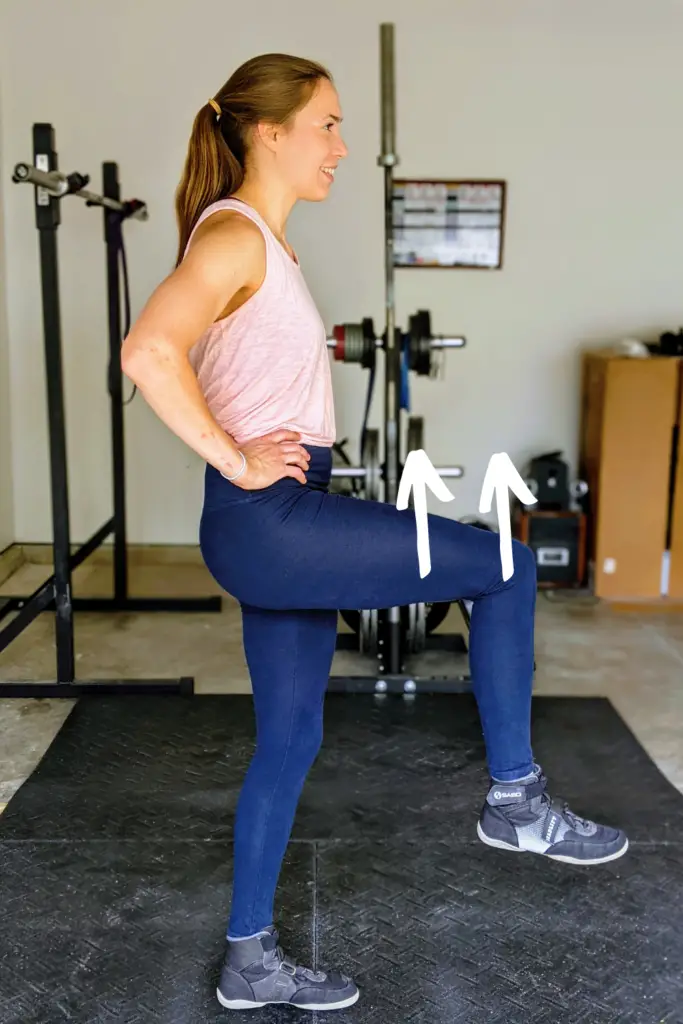
Bony overgrowth sounds scary. But it’s actually a frequent finding in pain-free hips. A diagnosis of FAI from X-rays doesn’t reliably correlate with pain.
In fact, 45% of men and 17% of women have FAI on imaging (5). And that’s in the pain-free population! Like with many conditions, imaging is small piece of the puzzle for FAI. X-rays can’t always distinguish a painful hip from a normal-feeling one.
Many cases of FAI fare well with conservative treatments like physical therapy, activity modification and home exercise.
Torn Labrum
A hip labral tear is another scary-sounding diagnosis that doesn’t always cause pain. One study found 39% of pain-free participants have labral tears in their hip! (6)
The labrum sits inside the hip socket and creates stability to keep the ball-and-socket functioning well. A torn labrum can cause symptoms like clicking, catching, locking and sudden sharp hip pain.
Much like FAI, most labral tears are asymptomatic and don’t require surgery. Strengthening the muscles around the hip joint is key to treating pain from a torn labrum. A labral tear reduces hip joint stability, but strong hip muscles offset this instability and reduce symptoms.
Trochanteric Bursitis
Trochanteric bursitis is a common diagnosis for lateral hip pain. Do you feel the bone on the outside of your hip?
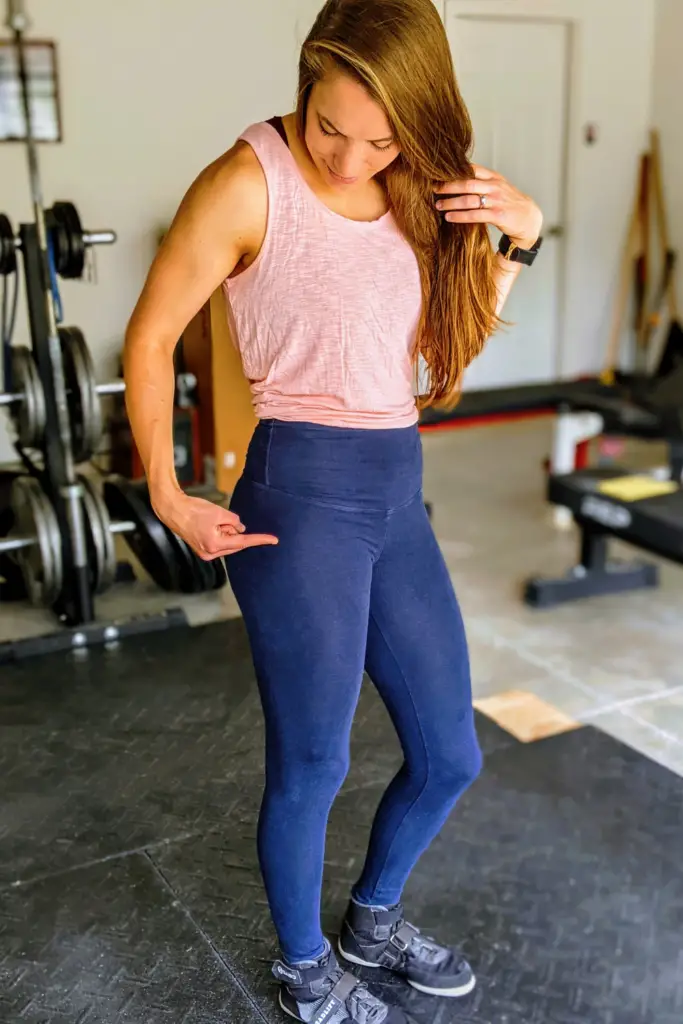
That’s your greater trochanter. Trochanteric bursitis is irritation of a fluid-filled sac (called a bursa) at this area. Muscular irritation causes lateral hip pain, too.
Several muscles attach at the greater trochanter, most prominently the gluteus medius. Pain, stiffness and trigger points in the gluteus medius cause trochanteric pain. Try these 3 simple strategies to relieve lateral hip pain:
- Reduce load on the lateral hip muscles
- Strengthen the lateral hip muscles
- Mobilize tight tissues on the outside of the hip
Find out more in the Exercises section
Referred Pain from the Spine
Last but not least, the lumbar spine is a frequent source of hip pain. It’s hard to believe, but repeated motions for the spine improve hip pain a whopping 71% of the time! (7)
Screening the spine is essential to treat hip pain effectively. Pain referred from the low back can cause unpredictable weakness, pain and instability in the hip. Lower back pain and sciatic nerve irritation are common symptoms of lumbar spine involvement.
That sudden, sharp hip pain could be coming from your lower back!
I use repeated lumbar motions to screen the spine before directing treatment at the hip. Missing a relevant lumbar component can leave you chasing symptoms around the hip without treating the root cause.
To learn how to use repeated motions to treat hip pain referred from your low back, pick up Treat Your Own Back, a best-selling book that’s helped thousands of people (including me) find pain relief.
Exercises
The good news is that the hip conditions described above can heal with exercise and physical therapy. Surgery is usually avoidable.
The following exercises alleviate pain and enhance the stability and function of the hip region. Exercise is one of the best routes to hip pain relief.
Mobility
Mobility exercises loosen up your hip joint. They’re especially productive if your hips feel tight and you struggle moving into certain positions.
Repeated Hip Extensions
Most of us sit a lot. This puts our hips in a flexed position. Hip flexion isn’t bad per se, but our hips can get stiff when we sit a lot.
This simple exercise moves the hip in the opposite direction, which can instantly reduce pain and stiffness–especially if sitting irritates your hip.
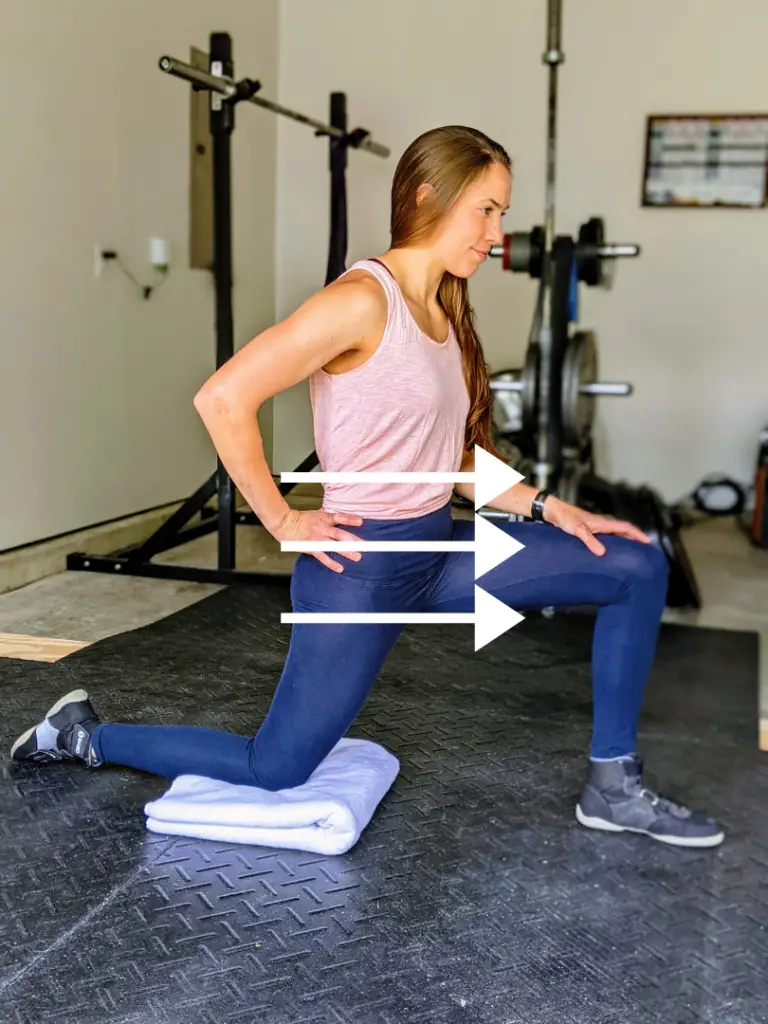
Keep the abs tight. Shift your pelvis forward, keeping the chest tall.
Try 10 to 15 repetitions with 3-second holds. Stretch further on each repetition.
Glute Release
This technique treats soft tissue issues at the outside of the hip. Grab a tennis ball or lacrosse ball and find a wall.
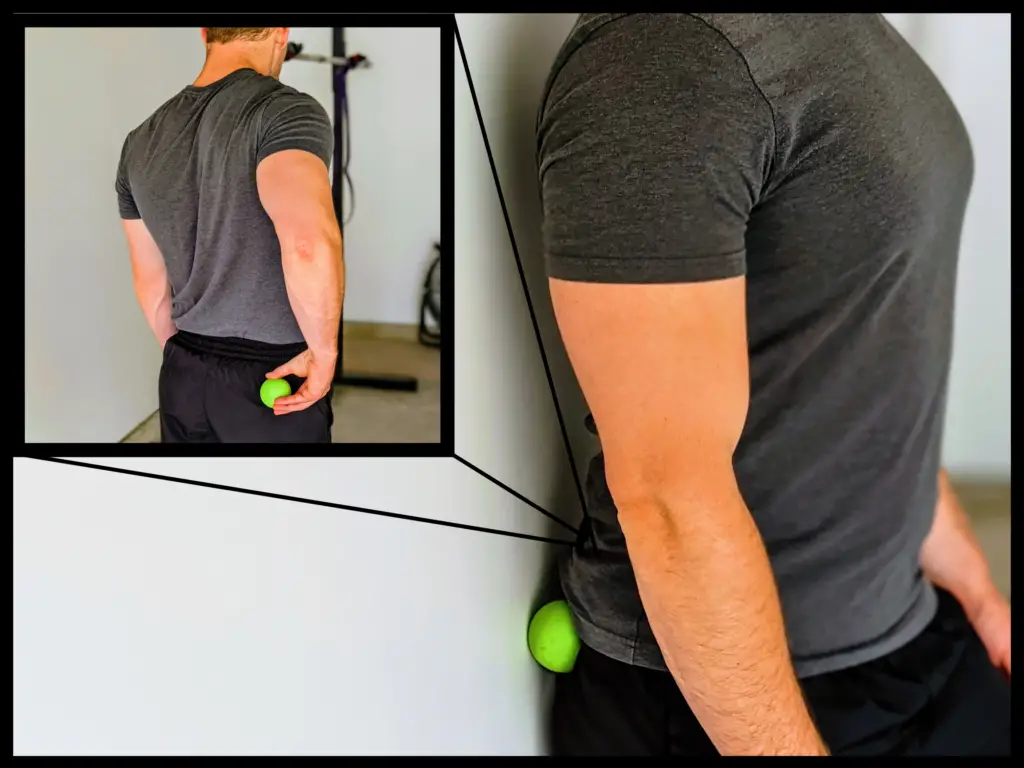
Move the ball around until you find a sore, tender spot in your hip muscles. Lean into the ball and hold pressure on the sore spot for 20 to 30 seconds. Then move to another tender area. Repeat as desired.
Deep, sustained pressure alleviates muscle tension and pain (8). Grab your pain relief tool here:

Banded Hip Mobilization: Lateral Glide
This technique creates space and movement between the ball and socket, simulating hands-on physical therapy treatments proven to reduce hip pain (3,9).
Lateral distraction is performed in half kneeling.
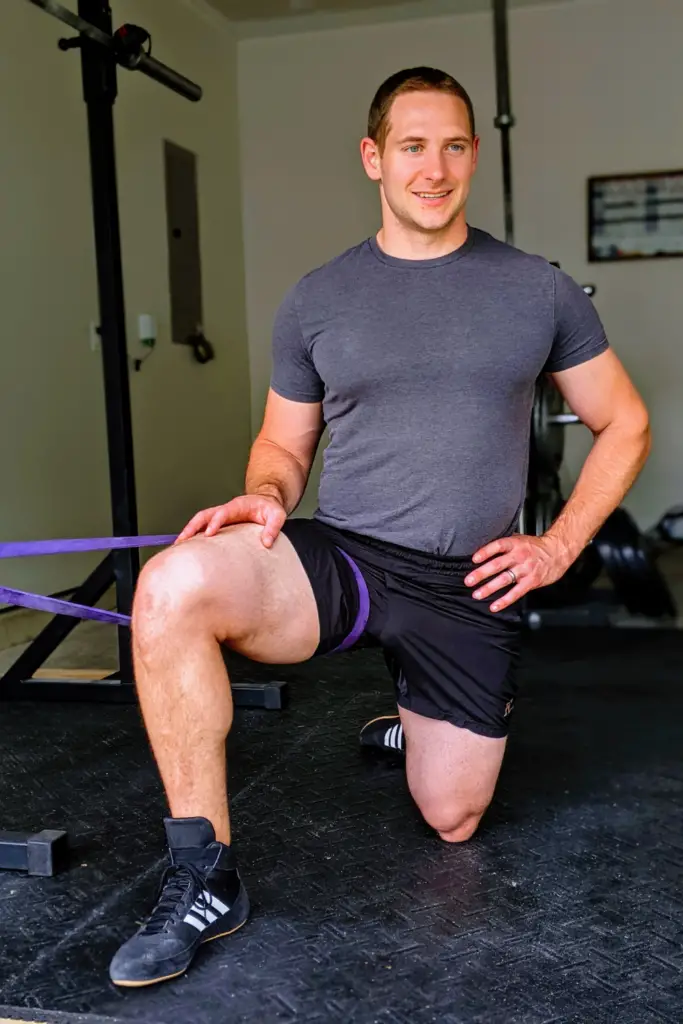
Gently move in and out of a stretch. This variation will help you get up and down the stairs, kneel and lunge with less pain. The mobilization should be pain-free.
Banded Hip Mobilization: Inferior Glide
Inferior glides will help you squat, lift your leg higher and sit more comfortably.
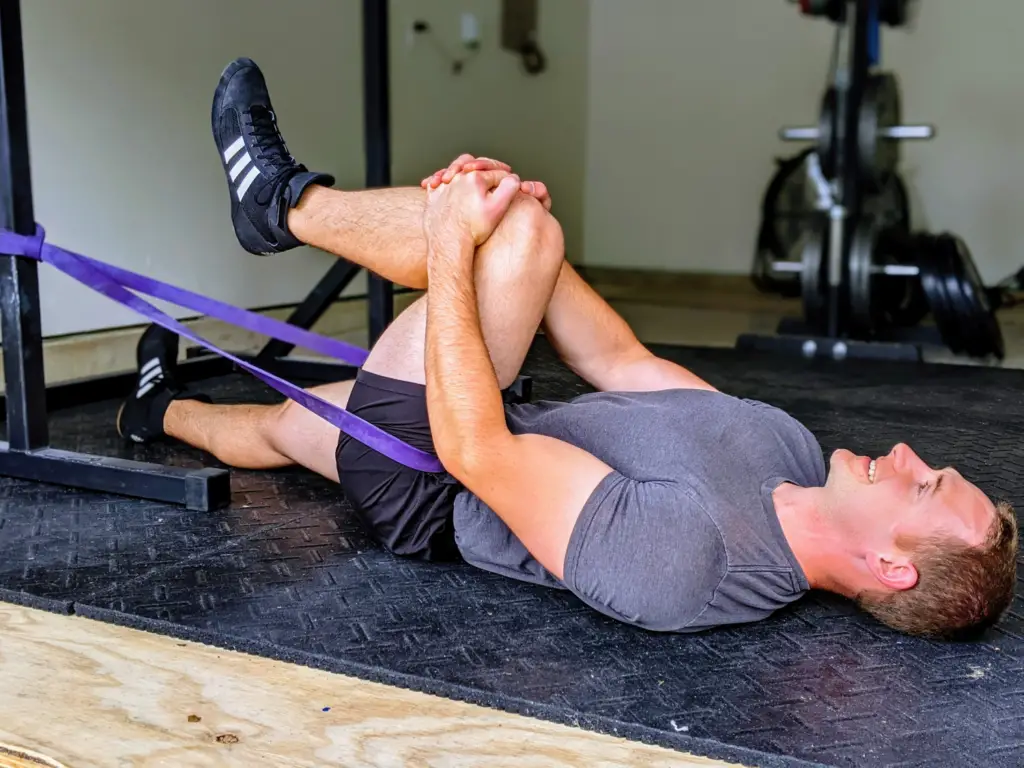
Slowly pull your knee towards your chest–without pushing through discomfort. Hold for 30-60 seconds, gently moving into and out of tight areas of the stretch.
A moderate to high-strength resistance band is ideal for this exercise.
Snag one here:

If sitting is a particularly aggravating position for you, learn other strategies to sit with less pain.
Strength
Beefing up the muscles around your hip will stabilize the joint and relieve pain. Strengthening is recommended for hip arthritis and non-arthritic hip pain (3,9).
Bridges
Bridges are simple exercises that strengthen the glutes, hamstrings and low back muscles. I’ll show you three variations, from easiest to hardest.
Level 1: Perform with arms on the floor, pushing through both legs to lift your hips off the floor.

Level 2: Same as Level 1, except with the arms across the chest

Level 3: Lift one leg, keeping the thighs parallel. Push through the leg that’s still on the floor to lift your hips up.

Level 4: (Bonus!) Same as Level 3, but with the arms across the chest. This one is tough!

Find the challenging-but-not-impossible level that suits you. Do 2-3 sets of 10-20 repetitions. Hold for a few seconds at the top and watch those glutes grow!
Hip Burners
This isometric exercise torches the gluteus medius muscle. And it’s usually pain-free!
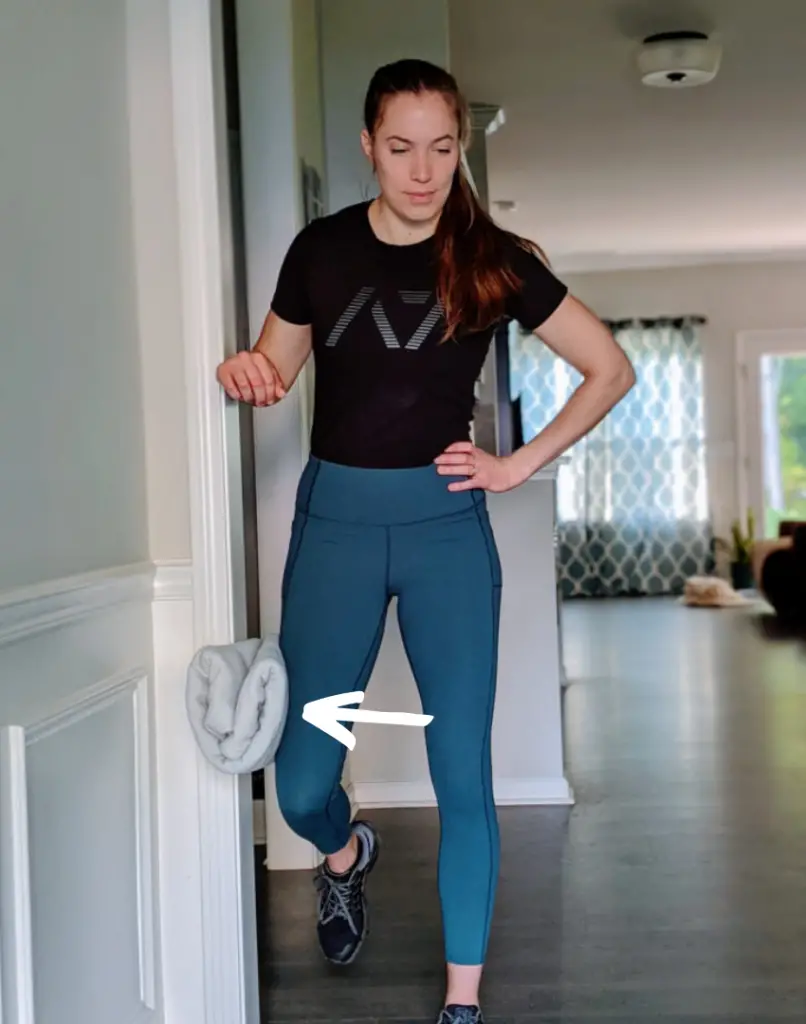
Gently push sideways into the towel. Hold 5 seconds. Relax. Repeat.
See if you can survive 10 reps of 5-second holds!
Side-Lying Hip Abduction
Lie on your pain-free side. The top leg does all the work.
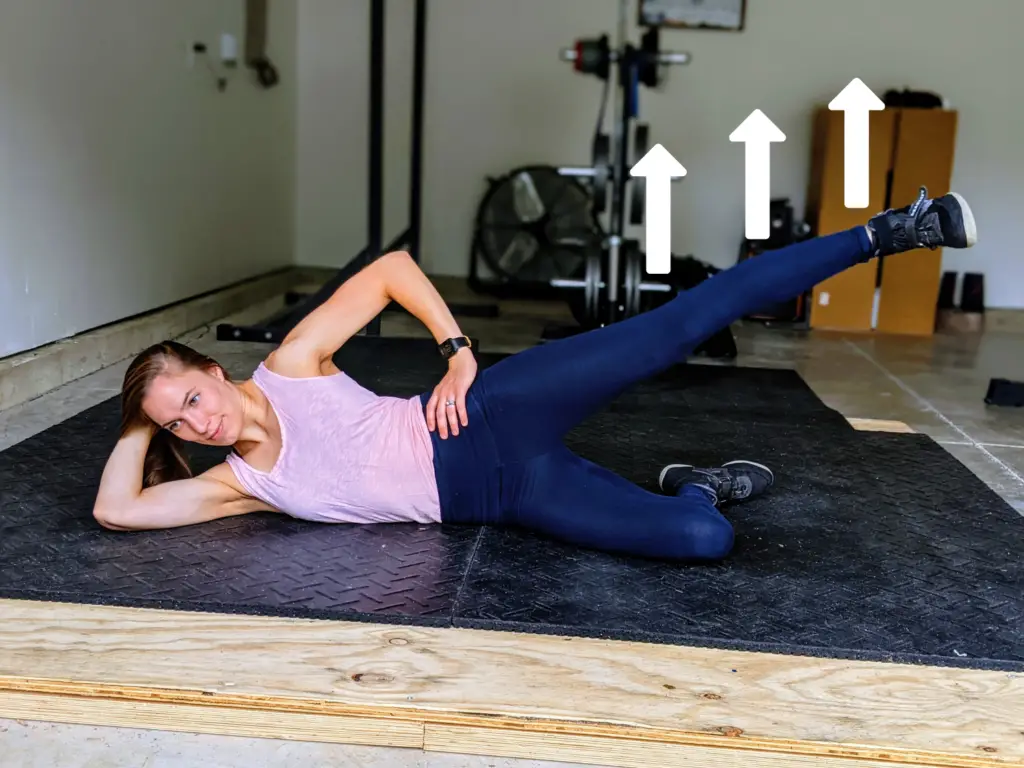
Keep your top leg straight. Slowly raise and lower. Maintain a straight line from your shoulders to your ankle.
The top hip likes to roll back to make the exercise easier–don’t let it happen to you!
Single Leg Stance
Standing on one leg seems simple, right? Try it out–hold for 20-30 seconds.

Too easy? Make it harder by closing your eyes or standing on a pillow or folded blanket. Or try it barefoot to get the intrinsic foot muscles into the action!
Hip muscles play a key role in balance–balance drills are a simple, non-impact method to enhance your hip stability. You’ll be balancing like a flamingo in no time!
General Exercise
In physical therapy there’s a saying, “motion is lotion.” Our bodies are made to move, and motion provides lubrication and nutrition to our joints.

Low-impact exercises like swimming, biking, walking and using the elliptical will keep your hips mobile and strong.
Other Conditions
Like any joint, most hip problems are musculoskeletal and don’t pose a major health risk. In rare cases, though, hip pain indicates a serious medical condition that requires prompt medical treatment.
These conditions should not be treated by physical therapy, chiropractic or exercise alone–a qualified physician needs to be part of your treatment team!
Hip Fractures
Hip fractures come in two varieties.
Traumatic Fractures
Broken bones around the hip joint happen after car accidents, falls and crush injuries. Sadly, many older adults fall on their hip and fracture their femur or pelvis. Falls are the most common cause of hip fractures (10).
Symptoms include severe hip pain and inability to bear weight on the injured side.
Stress Fractures
Stress fractures are different. They develop over time via repetitive stress on the bones–usually related to high impact activities. Stress fractures are common in long-distance runners (11).
Running and weight-bearing cause pain. Pain subsides with sitting or laying down.
Septic Arthritis
Septic arthritis occurs when the hip joint becomes infected. It happens after a surgery, injection or recent infection. Swelling, stiffness and fever are features of this rare condition (12).
Avascular Necrosis
AVN is an unusual condition caused by disrupted blood flow to the femoral head–the ball portion of the ball-and-socket joint. Risk factors include trauma, dislocation, and alcohol abuse.
Imaging via X-rays and MRIs helps diagnose avascular necrosis. But the pain pattern is usually consistent. Unpredictable symptoms aren’t common with AVN (13).
Summary
The hip is an intricate region. There are numerous possible causes of hip pain. See your local physical therapist for a thorough assessment and physical exam–your PT can figure out the cause of your hip pain and work with you to develop an effective treatment plan.
Dealing with low back symptoms too? Learn 3 great exercises for low back pain or find out about common low back pain mistakes.
Thanks for reading. Leave a comment below and share your thoughts.
For more evidence-based insights you won’t find anywhere else, join the free, fast-growing Facts & Physio Newsletter. Plus, get The Recovery Checklist when you sign up.
References
- https://www.ncbi.nlm.nih.gov
- https://www.medscape.com
- https://www.jospt.org
- https://www.ncbi.nlm.nih.gov
- https://www.ncbi.nlm.nih.gov
- https://pubmed.ncbi.nlm.nih.gov
- https://www.tandfonline.com
- https://www.ncbi.nlm.nih.gov
- https://www.jospt.org
- https://www.uofmhealth.org
- https://www.ncbi.nlm.nih.gov
- https://www.ncbi.nlm.nih.gov
- https://www.ncbi.nlm.nih.gov

